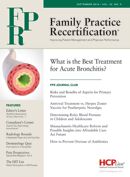Publication
Article
Family Practice Recertification
Antiviral Treatment vs. Herpes Zoster Vaccines for Postherpetic Neuralgia
Author(s):
This review and meta-analysis assessed whether antiviral treatment given during the acute herpes zoster rash is effective at preventing postherpetic neuralgia in patients with a first-time case of shingles.

Frank J. Domino, MD
Review
Chen N, Li Q, Yang J, Zhou M, Zhou D, and L He. Antiviral treatment for preventing
postherpetic neuralgia (Review). The Cochrane Collaboration. 2014: 1-33.
This review and meta-analysis assessed whether antiviral treatment given during the acute herpes zoster rash is effective at preventing postherpetic neuralgia in patients with a first-time case of shingles.
Methods
This meta-analysis searched relevant databases for all-language RCTs evaluating the efficacy of antiviral treatment in prevention of postherpetic neuralgia (PHN). The authors included studies in which antiviral treatment was started within 72 hours of zoster onset. The primary outcome of interest was incidence of PHN 6 months after zoster onset. Secondary outcomes included pain severity, quality of life measures, and adverse effects during and immediately after the treatment period. The authors completed a rigorous evaluation of risk of bias and their results were reported as relative risk ratios.
Patient Demographics
The patient populations included in this study consisted of patients with acute herpes zoster who were enrolled in the trial within 72 hours of symptom onset. There were no age or severity restrictions. Subgroup analysis included time to treatment (less than or greater than 24 hours) and age (less than 49 or greater than 50 years of age.)
Intervention (and control)
The intervention in question is the use of oral or intravenous antivirals administered beginning within 72 hours of symptom onset. Five of 6 studies included evaluated acyclovir for varying durations of therapy while the remaining study tested two different doses of famciclovir. The studies included for review compared antiviral treatment with placebo. Studies comparing antiviral treatment to steroids were excluded.
Outcomes & Main Results
Meta-analysis of five trials comparing acyclovir with placebo concluded there was no significant difference in the incidence of PHN between the acyclovir groups and the placebo groups (RR 1.05, 95% CI 0.87 to 1.27, P = 0.62). The sixth trial compared the incidence of pain after rash healing in patients taking famciclovir 500 mg, famciclovir 750 mg, or placebo. The relative risk of pain after rash healing with 500 mg of famciclovir and 750 mg of famciclovir, respectively, was 1.15 (95% CI 0.87 to 1.52) and 1.31 (95% CI 1.01 to 1.71), indicating no significant difference between the oral famciclovir groups and the placebo group.
Meta-analysis of 4 trials that included data on the presence of herpetic neuralgia 1 month after onset was also conducted and revealed a statistically significant decrease in incidence of pain reported in the acyclovir group compared to the placebo group. 44.1% of participants taking acyclovir reported pain at 1 monthh while 53.3% of participants taking placebo reported pain (RR 0.83, 95% CI 0.71 to 0.96, P = 0.01).
No serious adverse effects were attributed to either acyclovir or famciclovir in these studies. The most commonly reported adverse effects in patients in the acyclovir trials were nausea, vomiting, diarrhea, and headache: 50.1% of patients on acyclovir and 49.2% of patients taking placebo reported adverse effects; a non- significant difference (RR 1.01, 95% CI 0.88 to 1.15, P = 0.91). The most commonly reported adverse effects in patients in the famciclovir trial were headache and nausea; again there was no statistically significant difference in adverse event incidence between groups.
Commentary
There are more than 1 million cases of herpes zoster, caused by reactivation of a previous varicella infection, each year in the United States. This illness, which is characterized by prodromal pain and a vesicular rash, is sometimes accompanied by debilitating or uncomfortable postherpetic neuralgia. Postherpetic neuralgia was defined by the authors of this review as persistent pain 120 days or longer after the acute phase of herpes zoster. Estimates claim that postherpetic neuralgia is present in anywhere from 10-50% of cases of herpes zoster and there is a clear increase in incidence with increasing age (incidence of 40% in people 50 or older vs. incidence of 75% in people 75 or older).
Current treatment guidelines for herpes zoster recommend use of antivirals (acyclovir, valacyclovir, or famciclovir) in immunocompromised patients and in patients with other risk factors or severity indicators, such as age greater than 50 years or involvement of the face or eye. In these individuals during the acute phase of herpes zoster, antiviral treatment has been shown to decrease pain severity and speed resolution of lesions (Cohen, JI. Herpes zoster. N Engl J Med. 2013; 369:255-263).
However, conflicting studies disagree on the efficacy of this same antiviral treatment in preventing postherpetic neuralgia. While tricyclic antidepressants, gabapentin, lidocaine skin patch, and opioids have been found to reduce the pain of postherpetic neuralgia, they are not preventive medications.
This Cochrane Database meta-analysis attempts to answer the question of efficacy of antiviral treatment in preventing postherpetic neuralgia. After determining which of the studies would be included in the analysis, the authors rigorously assessed the risk of bias in each study and assigned each study a high, low, or uncertain risk of bias. Five of the studies in question were assigned an unclear risk of bias and one study was assigned a low risk of bias: no studies were evaluated as having a high risk of bias. In particular, the authors determined that blinding and completeness of outcomes data were satisfactory in each of the studies.
This meta-analysis determined based on the five trials included that there was no significant difference in the incidence of PHN between participants treated with oral acyclovir and participants given placebo. While the study of famciclovir revealed no significant difference in incidence of PHN for either dose of famciclovir compared to placebo, the authors acknowledge the need for further studies of antivirals other than acyclovir to actually determine their efficacy.
Despite no statistically significant effect of antivirals in preventing postherpetic neuralgia, there was a statistically significant decrease in the incidence of pain reported one month after onset of herpes zoster in the participants of 4 studies who were treated with acyclovir instead of placebo. No serious adverse effects attributable to treatment with antivirals were reported in the included trials and there was no statistically significant difference in adverse effects between the antiviral treatment and placebo groups.
The biggest strength of this review was the inclusion of studies with complete and similar data, allowing the authors to complete a meta-analysis of the data and obtain relative risk ratios and confidence intervals that successfully answer the primary question of antiviral efficacy in preventing postherpetic neuralgia. The six studies included are high-quality RCTs with broad patient demographics, increasing the external validity of the data. However, inclusion of only six studies is also a limitation of this review. There was, for example, limited data to complete a funnel plot analysis or to make good assessments of quality of life measures related to antiviral treatment and postherpetic neuralgia.
One of the largest limitations of this study is lack of complete subgroup analysis. As the authors point out, they did not conduct subgroup analysis of high-risk patients for zoster, such as immunocompromised individuals. They also lacked sufficient data for a complete analysis of subgroups: comparing patients by and comparing patients with treatment initiated in the first 24 hours after symptom onset vs. those with treatment initiated 24-72 hours after symptom onset. Additionally, they did not obtain enough complete data for analysis of standardized quality of life measures or pain severity at multiple time points.
Based on the conclusions reached by this meta-analysis, physicians should continue to treat zoster patients with indications for antiviral therapy, such as immunocompromised patients or patients over the age of 50, but should recognize the lack of data showing antivirals as a preventive measure against postherpetic neuralgia. TCAs, gabapentin, lidocaine patches, and opioids remain the medications of choice for their proven efficacy in treating postherpetic neuralgia.
There is a bright side; the attenuated herpes zoster vaccine’s ability to prevent postherpetic neuralgia. Currently recommended as a one-time vaccine by the CDC for patients 60 years or older and approved for patients over 50 years of age, the zoster vaccine is efficacious not only at preventing herpes zoster but also at preventing postherpetic neuralgia in patients who have herpes zoster despite vaccination. The efficacy of the vaccine in preventing acute herpes zoster is 70% for persons 50 to 59 years of age, 64% for persons 60 to 69 years of age, and 38% for persons 70 years of age or older. Despite its diminishing efficacy for preventing herpes zoster with increasing age, the vaccine remains approximately 66% effective at preventing postherpetic neuralgia in all patients over 60 years of age. It has also been proven to result in less severe pain of significantly shorter duration (Cohen 2013).
While this meta-analysis indicates the lack of efficacy of antiviral therapy in preventing postherpetic neuralgia, physicians should be encouraged to recommend administration of the zoster vaccine in appropriate patients in because of its efficacy, and the lack of efficacy of antiviral therapy.
About the Author
Frank J. Domino, MD, is Professor and Pre-Doctoral Education Director for the Department of Family Medicine and Community Health at the University of Massachusetts Medical School in Worcester, MA. Domino is Editor-in-Chief of the 5-Minute Clinical Consult series (Lippincott Williams & Wilkins).
Additionally, he is Co-Author and Editor of the Epocrates LAB database, and author and editor to the MedPearls smartphone app. He presents nationally for the American Academy of Family Medicine and serves as the Family Physician Representative to the Harvard Medical School’s Continuing Education Committee.

2 Commerce Drive
Cranbury, NJ 08512
All rights reserved.





